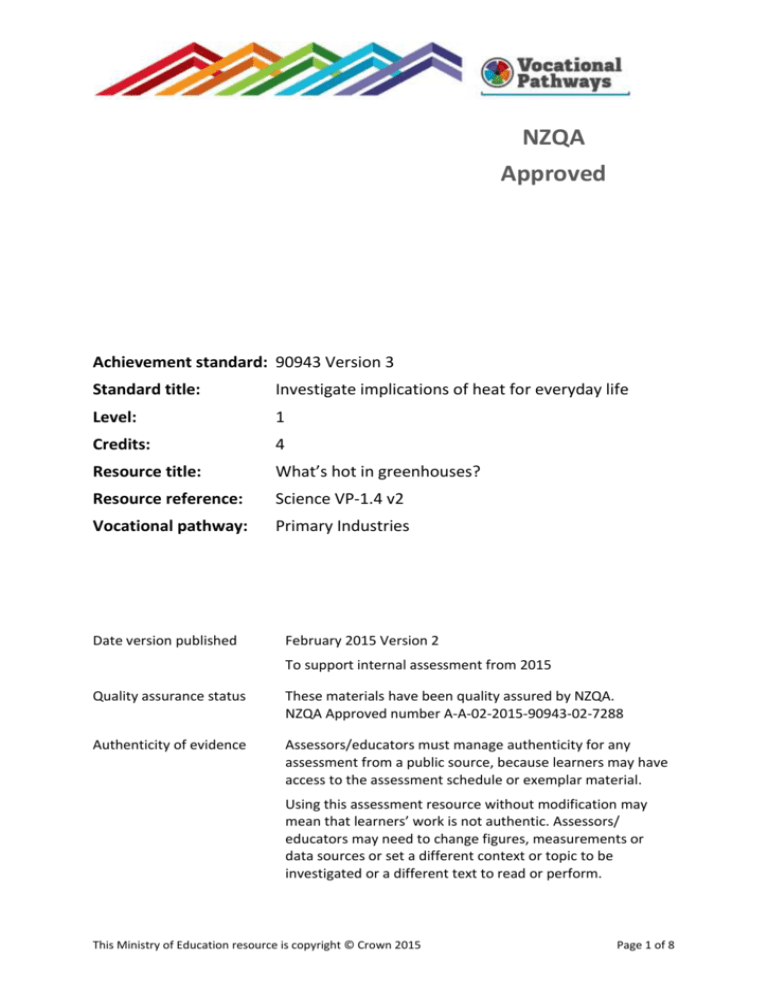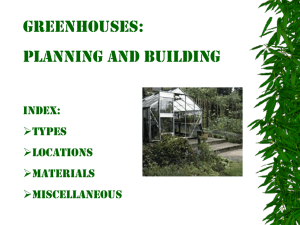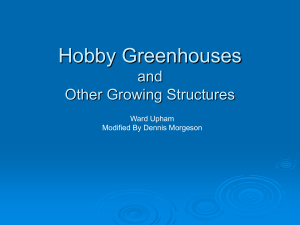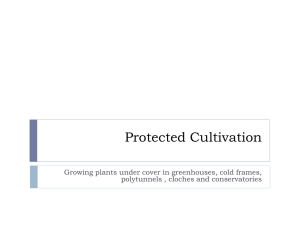What`s hot in greenhouses?
advertisement

NZQA Approved Achievement standard: 90943 Version 3 Standard title: Investigate implications of heat for everyday life Level: 1 Credits: 4 Resource title: What’s hot in greenhouses? Resource reference: Science VP-1.4 v2 Vocational pathway: Primary Industries Date version published February 2015 Version 2 To support internal assessment from 2015 Quality assurance status These materials have been quality assured by NZQA. NZQA Approved number A-A-02-2015-90943-02-7288 Authenticity of evidence Assessors/educators must manage authenticity for any assessment from a public source, because learners may have access to the assessment schedule or exemplar material. Using this assessment resource without modification may mean that learners’ work is not authentic. Assessors/ educators may need to change figures, measurements or data sources or set a different context or topic to be investigated or a different text to read or perform. This Ministry of Education resource is copyright © Crown 2015 Page 1 of 8 Internal assessment resource: Science VP-1.4 v2 – Vocational pathway: Primary Industries PAGE FOR LEARNER USE Vocational Pathway Assessment Resource Achievement standard: 90943 Standard title: Investigate implications of heat for everyday life Level: 1 Credits: 4 Resource title: What’s hot in greenhouses? Resource reference: Science VP-1.4 v2 Vocational pathway: Primary Industries Learner instructions Introduction This assessment activity requires you to investigate the implications of heat transfer in greenhouses (also known as glasshouses) used to grow plants. You are going to be assessed on how comprehensively you investigate the implications of heat for everyday life, such as how heat is transferred and maintained in greenhouses to provide the warmth required to grow plants commercially. The following instructions provide you with a way to structure your work so you can demonstrate what you have learnt and achieve success in this standard. Assessor/educator note: It is expected that the assessor/educator will read the learner instructions and modify them if necessary to suit their learners. Task Greenhouses are structural buildings of varying sizes with different types of covering materials, such as glass and/or plastics. They are used to grow flowers and vegetables commercially on a large scale. Greenhouses heat up because energy from the sun is absorbed by plants, soil and other things inside them. They are designed to retain the heat required to grow plants indoors for most of the year, for example tomatoes, cucumbers and roses. Testing different types of materials used in the design of greenhouses for this purpose requires the ability to understand how heat is transferred in them. You will produce a report for a horticulture journal that explains heat transfer ideas relevant to the selection of materials and design features for a new greenhouse. Your report will use the experimental data and observations you have gathered to explain aspects of how heat energy is transferred for growing plants in greenhouses. You will use primary evidence and/or secondary data from your investigation to support your explanations in your report. This Ministry of Education resource is copyright © Crown 2015 Page 2 of 8 Internal assessment resource: Science VP-1.4 v2 – Vocational pathway: Primary Industries PAGE FOR LEARNER USE Gather primary data Using a range of materials provided by your assessor/educator, and working in a group of up to three learners, investigate how heat energy is transferred in a ‘model’ greenhouse to provide the heat energy required for growing plants. Record your data in an organised way, for example by drawing and labelling diagrams or using data tables linked to any observations you make (for example changes in temperature). Make sure each member of your group agrees on and records the same data. Gather secondary data In any building design, some of the heat in air warmed by the sun is retained by the roof and walls. Over time, however, this heat will be lost unless it is replaced and/or its loss is reduced and controlled. Work independently to collect relevant information on how heat is transferred in greenhouses to provide the heat energy required by plants grown commercially. Collect enough information to allow you to discuss the links between the scientific theory of heat transfer and the results of your experiment, for example identifying and explaining the general mechanisms of heat transfer in greenhouses. This can also include the role of artificial heating systems, for example boilers and heaters, required when there is insufficient heat energy provided by the sun. Prepare and present your report Produce a report that comprehensively explains how heat is transferred to provide the heat energy needed to grow plants commercially in greenhouses. Include in your report: data you have gathered (for example information and experimental data results) how the temperature of the heat is measured and recorded how heat is transferred by radiation, convection and conduction how heat is/could be lost in a greenhouse why heat loss should be prevented why some materials show a change of phase at certain temperatures evidence of your own critical thinking, for example you might elaborate, justify, relate, evaluate, compare and contrast, or analyse the science information you have gathered to discuss ideas relating to heat transfer about the suitability of greenhouse designs, i.e. why some materials are better to use than others the scientific theory of heat transfer as you critically evaluate the implication of heat transfer in greenhouse designs. This Ministry of Education resource is copyright © Crown 2015 Page 3 of 8 Internal assessment resource: Science VP-1.4 v2 – Vocational pathway: Primary Industries PAGE FOR ASSESSOR/EDUCATOR USE Vocational Pathway Assessment Resource Achievement standard: 90943 Standard title: Investigate implications of heat for everyday life Level: 1 Credits: 4 Resource title: What’s hot in greenhouses? Resource reference: Science VP-1.4 v2 Vocational pathway: Primary Industries Assessor/Educator guidelines Introduction The following guidelines are supplied to enable assessors/educators to carry out valid and consistent assessment using this internal assessment resource. As with all assessment resources, education providers will need to follow their own quality control processes. Assessors/educators must manage authenticity for any assessment from a public source, because learners may have access to the assessment schedule or exemplar material. Using this assessment resource without modification may mean that learners' work is not authentic. The assessor/educator may need to change figures, measurements or data sources or set a different context or topic. Assessors/educators need to consider the local context in which learning is taking place and its relevance for learners. Assessors/educators need to be very familiar with the outcome being assessed by the achievement standard. The achievement criteria and the explanatory notes contain information, definitions, and requirements that are crucial when interpreting the standard and assessing learners against it. Context/setting This activity requires learners to comprehensively investigate and produce a report on how heat is transferred in greenhouses to provide sufficient heat energy to grow plants commercially. Learners will perform a practical investigation with direction, conduct research and then process this information to present a report of their findings. The findings and conclusions in their report should link their prior knowledge, understanding of the scientific theory of heat, the information gathered, and their experimental data. The aspects of heat in this assessment are based on heat transfer and require prior knowledge of heat energy, radiation, convection, conduction, specific heat capacity, and temperature as a measure of heat energy. This Ministry of Education resource is copyright © Crown 2015 Page 4 of 8 Internal assessment resource: Science VP-1.4 v2 – Vocational pathway: Primary Industries PAGE FOR ASSESSOR/EDUCATOR USE Conditions Learners could work in groups of no more than three to gather the required experimental results. Learners should work independently to gather secondary information and to produce their reports. Resource requirements Provide each group with: a variety of plastics and glass and other materials, for example wire, to design ‘model’ greenhouses small potted plants laboratory equipment, for example thermometers access to the sun outside or an appropriate indoor light source. Additional information Provide specific guidance or instructions to learners about how to carry out the experiment(s). Gathering of primary data can be carried out independently or in groups. Final work will be individually assessed. Decide on the format of the final presentation. It could be a written report, oral presentation, poster, PowerPoint, or any other suitable format. You may wish to take learners’ preferences into account in deciding on the format. Procedures outlined in Safety in Science: a Guidance Manual for New Zealand Schools, Learning Media, Ministry of Education, 2000 should be followed. Safety guidelines must be given and safety equipment, for example safety glasses, must be provided. Other possible contexts for this vocational pathway Heat transfer related to systems used in chicken farming. Heat transfer related to collecting and storing milk on dairy farms; transporting milk to treatment stations in milk tankers or the milk train used by Fonterra. This Ministry of Education resource is copyright © Crown 2015 Page 5 of 8 Internal assessment resource: Science VP-1.4 v2 – Vocational pathway: Primary Industries PAGE FOR ASSESSOR/EDUCATOR USE Assessment schedule: Science 90943 – What’s hot in greenhouses? Evidence/Judgements for Achievement Evidence/Judgements for Achievement with Merit Evidence/Judgements for Achievement with Excellence The learner investigates implications of how heat is transferred in greenhouses to provide sufficient heat energy to commercially grow plants. At least one of the following is required: collecting and processing primary evidence from an investigation and relating it to the scientific theory relevant to the implications of heat transfer collecting and processing secondary data and identifying the scientific theory relevant to the implications of heat transfer in greenhouses For example, the learner describes: - how heat is transferred (conduction, convection and/or radiation) in the design of greenhouses for plant growth (the report may include a diagram or narrative description of experimental results) - how greenhouses are framed structures with roofs and walls made of glass or plastics - how heat flows from the sun through the air and then through the plastic or glass of the greenhouse by radiation The main transfer of heat energy inside my ‘model’ greenhouse made of glass was by convection. Without a plant inside the temperature went from … oC to … oC in 30 The learner investigates, in depth, implications of how heat is transferred in greenhouses to provide sufficient heat energy to commercially grow plants. At least one of the following is required: collecting and processing primary evidence from an investigation and relating it to the scientific theory relevant to the implications in order to give an explanation of heat transfer collecting and processing sufficient and relevant secondary data and applying scientific theory to explain the implications of heat transfer in greenhouses For example, the learner explains: - methods of heat transfer (conduction, convection and/or radiation), related to how heat is transferred in the design of greenhouses for plant growth - why greenhouses are lightly framed structures of varying sizes, with roofs and walls made of glass or transparent, strong plastics designed to withstand the weather - why a greenhouse heats up because incoming visible solar radiation (which is why the glass is transparent) from the sun is absorbed by plants and other things inside the building like the soil and metal supporting structures - why the warmed structures and plants inside The learner investigates, comprehensively, implications of how heat is transferred in greenhouses to provide sufficient heat energy to commercially grow plants. At least one of the following is required: collecting and processing primary evidence from an investigation and relating it to the scientific theory relevant to the implications in order to give a comprehensive and critical explanation of heat transfer collecting sufficient and relevant secondary data and applying scientific theory to critically evaluate the implications of heat transfer in greenhouses For example, the learner explains comprehensively: - how heat is transferred (conduction, convection and/or radiation) in the design of greenhouses, and the links to plant growth - why the warmed structures and plants inside the greenhouse re-radiate some of their heat energy in the infrared spectrum, to which glass is partly opaque, so some of this energy is also trapped inside the greenhouse. The main heating mechanism inside a greenhouse is by convection. This can be shown by opening a small window This Ministry of Education resource is copyright © Crown 2015 Page 6 of 8 Internal assessment resource: Science VP-1.4 v2 – Vocational pathway: Primary Industries PAGE FOR ASSESSOR/EDUCATOR USE minutes. - how the main problem with heating a greenhouse as opposed to a building that has solid walls is the loss of heat through the covering. As the coverings need to allow light to filter into the greenhouse they are not well insulated. The above expected learner responses are indicative only and relate to just part of what is required. the greenhouse re-radiate some of their heat energy so some of this energy is also trapped inside In my experiment, the transfer of heat from the sun to the inside of my model greenhouse made of clear plastic was through the air by radiation and convection. Without a plant inside the temperature rose from … oC to … oC in 30 minutes. With a plant inside the temperature only rose from oC to … oC in 30 minutes. - how the design of a greenhouse is related to the transfer of heat energy for plant growth - why the main problem with heating a greenhouse (as opposed to a building that has solid, opaque walls) is the amount of heat lost through the greenhouse covering. Since the coverings need to allow light to filter into the structure, they conversely cannot insulate very well - why commercial glass greenhouses are often high-tech production facilities for growing vegetables or flowers. They are filled with equipment such as screening installations, heating, cooling and lighting, and may be automatically controlled by a computer. The above expected learner responses are indicative only and relate to just part of what is required. - - - This Ministry of Education resource is copyright © Crown 2015 near the roof − the temperature drops considerably. This principle is the basis of the ‘autovent’ automatic cooling system. The glass used works as a barrier to air flow, and its effect is to trap energy within the greenhouse. The air that is warmed near the ground is prevented from rising indefinitely and flowing away. Although heat loss due to thermal conduction through the glass and other building materials occurs, net energy (and therefore temperature) increases inside the greenhouse. When extra heat is needed most commercial greenhouses use natural gas or electrical furnaces. Electronic controllers are often used to monitor the temperature and adjust the furnace operation to the conditions. This can be as simple as a basic thermostat, but can be more complicated in larger greenhouse operations recommendations on the design of greenhouses based on the evidence from their data the relative amounts of energy transferred using different glass and plastic coverings and the implications of this limitations of their experiment and the effect on their conclusions/findings variations between their experimental data and any prior or researched science knowledge, and reasons why these variations have happened. Page 7 of 8 Internal assessment resource: Science VP-1.4 v2 – Vocational pathway: Primary Industries PAGE FOR ASSESSOR/EDUCATOR USE The above expected learner responses are indicative only and relate to just part of what is required. Final grades will be decided using professional judgement based on an examination of the evidence provided against the criteria in the Achievement Standard. Judgements should be holistic, rather than based on a checklist approach. This Ministry of Education resource is copyright © Crown 2015 Page 8 of 8









